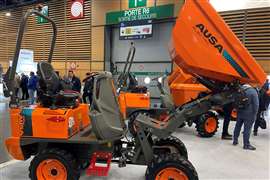World telehandlers
28 January 2020
Manufacturers are expanding their ranges in terms of capacity and geography, while rotating and compact products are seeing a significant growth in sales.
Specialist market research and forecasting company Off-Highway Research expects the global market for telehandlers to reach some 75,000 units this year.
About two thirds of demand for this type of machine is in Europe and North America, the regions which represent the vast majority of production. While telehandlers sell in other parts of the world, there is competition from other types of equipment such as locally built mobile cranes in Asia. The outlook for the segment is reasonable. Although sales this year are likely to be down from the high seen in 2018, volumes should stay relatively high at some 70,000 units per year for the next few years, says Off-Highway Research.
In a bid to address a comparative lack of interest in telehandlers outside of North American and Europe, Manitou has launched models aimed specifically at emerging markets, and is opening an assembly plant in India to produce them.
The identical Manitou MXT 840 and Gehl TX 408 telehandlers are aimed at Asia, Middle East, Eastern Europe and Russia and are designed to be more rugged and easy to use than their counterparts produced in Europe. They also come at a significantly lower cost. The main specifications are a 7.6m lifting height and a maximum capacity of 4 tonnes. They are particularly suited to building construction and can easily extend to two storeys.
The equipment also has three steering modes: 2-wheel steer, 4-wheel steer or grab mode. They have 39cm high clearance and are therefore suited to difficult terrain. Transmission consists of a torque converter gear box, while power comes from a 95hp, Stage 3a engine. While the chassis and boom are very robust.
The manufacturer has stripped away standard items found on Europe-based equipment, including all electronics and plastics, meaning the whole unit is made of steel and therefore easier to maintain in the field. Both units have been available since June.
Emerging potential
Michel Denis, president and CEO of Manitou, told AI. “We see in these markets that the usage can be very hard, for example we have a number of customers in Russia running them 24 hours a day, seven days a week.” In response, the telehandler units have undergone 2000 hours of endurance testing.

Manitou has presented a third telehandler, the MXT 1740, with equally rugged qualities. It has a 17m lifting height and 4 tonne capacity. It will be available in the first quarter of 2020 and will be attractive to markets like the Middle East where 18m telehandlers are the primary choice of customers. The company believes there is room for up to 60,000 telehandler units in the Asia and Middle East markets alone, “Our choice [in these new products] is justified by the telehandler needs that are growing significantly in the short and long term due to progressive modernisation projects.”
It is thought the models are ideal for replacing cranes, wheeled loaders and other material handling techniques used extensively for the type of work a telehandler does. The pick and carry crane commonly seen in India being just one example. Manitou is also breaking new ground with the launch of its 100% electric range, known as the Oxygen line. Two new telehandlers feature in this range alongside a new access platform.
The MRT 2550 h Oxygen Lab telehandler is a hybrid prototype version of the diesel MRT 2550 model, capable of operating in 100% electric mode. Retaining the same characteristics as the diesel-powered version, it has 25 m lifting height with a capacity of 5 tonnes.
Representing a new concept is the MT 625 e Oxygen. It is a lightweight telehandler designed to accommodate an electric engine. The cab has also been redesigned with new intuitive operator aids. Natural, contemporary and sustainable materials, including wood, are also used in the cab, an example of the group’s eco-design policy.
Arnaud Sochas, innovation manager for Manitou, said, “Players in the construction market are faced with increasing demand for flexible, low-carbon solutions, especially for urban work sites. With the Oxygen label, the Manitou group wants to provide a concrete response to these needs. Responding to mining activity requirements, the company also introduced the high capacity diesel MHT 12330 telehandler at Bauma. It has a lifting height of 12 m, with a capacity ranging from 33 tonnes with forks to 36 tonnes with hook. Equipped with a 182 Kw Deutz stage V engine, this model also benefits from special protective covers on the work road lights.
Rotating news
Italian manufacturer Magni is firmly placed in the mature markets, specialising as it specialises in the more complex and expensive rotating telehandler. While the company believes the global market for these more niche rotating machines is around 3,000 units per year, it also sees growing opportunities in the segment, which is expanding at an annual rate of 30% to 35%. Magni plans to keep up with this demand thanks to major expansion of its production capabilities. The new 33,000 square metre facility is expected to be finished by May next year, with the first two buildings, making up 10,000 square metres, completed this December.
In an enterprising move, Magni will rent 10,000 square metres of the facility to its suppliers, incorporating three companies that provide logistics, painting and steel handling. Having these suppliers in such close proximity will save Magni around €500,000 a year, explains sales director Eugenio Magni. It also means Magni will have the capacity to produce 3,5000 machines each year and it will open up new possibilities for the company. Look out for more news on the reasons behind this expansion over the coming months.
One of the models on the new production lines will be the recently launched 13.26 RTH, which was designed to be the most powerful rotating telehandler in the world, says the company, with a 13 tonne capacity and 26m height. At the full 26m it can still carry 8 tonnes. Returning to the subject of cranes, Magni believes this rotating model can compete with a 40-45 tonne mobile crane, which he says is much more expensive for the same type of work. Magni adds, “A crane has to be rented with an operator. But you can rent our machines without an operator.”
New products are also on the horizon, as the manufacturer heads further up the capacity and height spectrum. ConExpo, taking place in Las Vegas next year, will see the launch of a new rotating machine along these lines, although the details are not yet available.
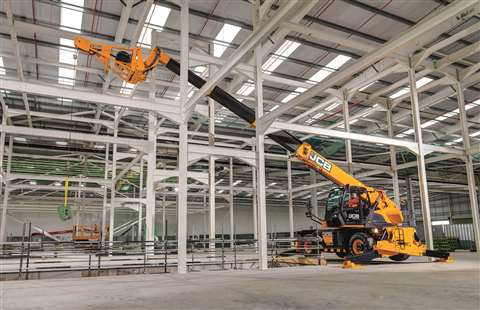
The premise that rotating telehandlers provide a convenient alternative to cranes is shared by JCB, which launched its first rotating model in June this year. The Hydraload 555-210R is the UK manufacturer’s response to the growth in popularity of rotating machines with heavier lift capacities across Europe. It offers a maximum lift capacity of 5.5 tonnes and maximum working height of 20.5m.
“Rotating telescopic handlers have become a genuine cost-effective replacement for smaller mobile cranes, offering rapid set-up and the ability to carry out technical lifting operations,” said a JCB spokesperson.
To minimise set up time, the outriggers have auto one-touch deployment, stowage and levelling. Competitive lift end cycle times and high auxiliary flow rates for efficient winch work, boost productivity further, says the manufacturer. The model also offers a lower chassis engine layout and a high level of visibility. A low boom design also provides all-round visibility, along with comprehensive work light options and camera kits, including a boom head camera for precise placement at height.
The machines are powered by JCB’s Ecomax engines, offering parts and service commonality with other Loadall models. The JCB LiveLink telematics system is fitted as standard. Easily selectable lift end speed profiles and lift envelope limits help the operator to optimise the machine for specific tasks. There are a range of available attachments; including a winch, jib winch, 5.5 tonne hook, light duty buckets, a range of fork-mounted accessories and access platforms.
Compact class
While the relatively niche sector of rotating machines is becoming increasingly mainstream, so is compact equipment. Expert in compact telehandlers, Ausa started manufacturing these machines in 2008. The range comprises three models, the T144H, T204H and T235H, which has the boom positioned on the side. It allows a more spacious cab with 360° visibility but reduces total width.
The T144H is specifically known for its compactness, at 1,405mm wide, and has a load capacity of 1,350kg and a lifting height of 4m. Thanks to its small dimensions, it is the only telescopic handler on the market in the 1 and 1.5 tonne category that can be placed on a traditional trailer.
The Taurulift T204H and T235H models in the 2 tonne and 2.3 tonne category have a lifting height of 4.4m and 5m, respectively. The company says, “Safety and the electrification of the machines are the two main trends in the sector nowadays.” For example, the load indicator on the T144H has an automatic overload limiter.
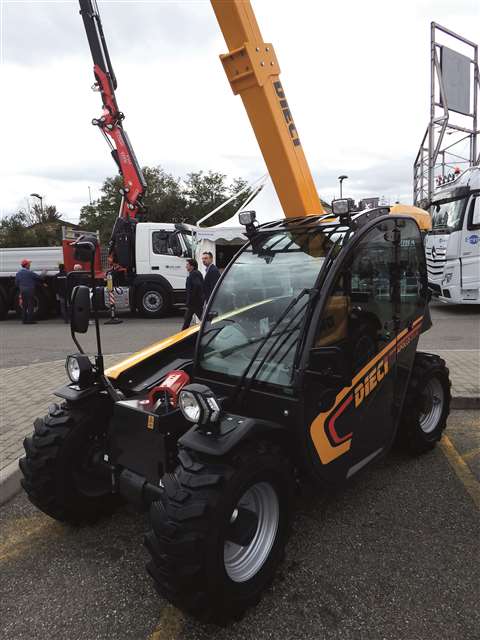
Sticking with the compact theme, Dieici has introduced the 2 tonne capacity ultra-compact Apollo 20.4. The model has 4m maximum working height, complemented by a small footprint – it is 1.5m wide and has a 1.8m transport height. The machine is at prototype stage and will be added to the product line in the second quarter of 2020. The company says its existing 26.6 model, with dimensions of 1.8m x 1.9m, has been in demand and customers requested an even smaller version, leading to the new prototype.
Haulotte’s new HTL 3207 telehandler is the most compact telehandler that the company has offered to date. The model utilises a hydrostatic transmission alongside an inching pedal for smooth and progressive driving. The company says that thanks to proportional movements, manoeuvring is intuitive, secure and precise. The HTL 3207 provides a maximum lift capacity of 3.2 tonnes, and is designed to lift any type of load up to a height of 6.85m.
With a short turning radius and a length of 4.67m, this new machine can easily access narrow spaces. The new compact telehandler has been built to be user friendly, with a spacious and ergonomic cab offering enhanced visibility. A fully adjustable seat with shock absorbers is included to reduce operator fatigue. The 4 in 1 joystick enables the operator to control movements more precisely and all controls have been specifically positioned to be easily accessible according to their frequency of use.
Finally, the load moment indicator which is positioned to be easily read includes an automatic cut off when operating with a tilting risk and an automatic reset in case of malfunction.
With the introduction of the 8m TL43.80HF and 7m TL30.70 models, Bobcat now offers a choice of 13 compact rigid frame telehandlers, covering capacities between 2.6 and 4.3 tonnes, with lifting heights from 6 to 18m. The new TL43.80HF ups the capacity in the range to 4.3 tonnes, in combination with the almost 8m lift height, and is designed with a high level of stability in mind, thanks to the box welded frame, the low load centre, the long wheelbase and the new rear counterweight. This has allowed overall dimensions to be minimised, resulting in a width of 2.3m and length of less than 5m from the rear to the fork face. Together with its short turning radius of 3.71m, the new model is very manoeuvrable.
Its sibling model, the TL30.70, provides a maximum lift capacity of 3 tonnes and a lift height of nearly 7m. Its compact 2.1m width and stability makes the machine a suitable tool for pick and go applications or for lifting materials on housing and commercial property developments. With a reach of 4m, it can carry a load of more than 1 tonne, while at maximum height, it can lift up to 2 tonnes, which is sufficient to place a pallet of heavy bricks in most conditions.
The range is powered by Bobcat’s own compact Stage IV D34 engine, for the highly regulated markets in EMEA. Combined with a low profile engine hood visibility has been improved on the engine side, a particular help for material handling applications. The engine is available in three different sizes – 75, 100 and 130 HP.
In contrast to Bobcat, Tobroco Giant has recently entered the telehandler market. The company’s first offering in this sector is the 4548 Tendo HD, with a second machine set to enter the market later this year. The 4548 Tendo HD is very compact at a width of just 1.6m and 2m high, with an inside turning radius of just 1.2m. This machine is capable of lifting objects weighing up to 1.4 tonnes to a height of 4.8m on forks and has a capacity of 1.5 tonnes at ground level or 1.2 tonnes at full height. The Tendo also has the option to be equipped with crab steering. This means it can drive laterally offset for better manoeuvrability close to structures.
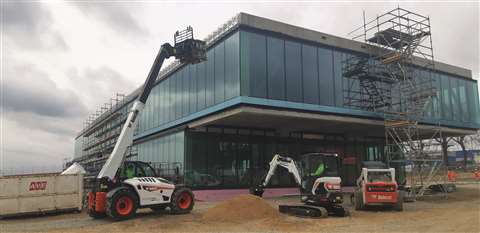
The new GT5048 telehandler, which will be released later in the year, will replace the existing model. When it becomes commercially available, the new telehandler will be powered by a 36kW, Kubota, diesel engine with catalytic converter (DOC) and DPF that meets the latest, EU Stage V, clean engine standards.
Emission drop
Genie has also been working on improving its emissions. The company says that its GTH-3007 compact telehandler will now feature Stage V-compliant engines keeping performance clean.
The Stage V units have been available for European countries and Turkey from July, 2019. As the heavier lifting, higher reaching brother of the Genie GTH-2506 compact telehandler, weighing 5970 kg, the GTH-3007 telehandler shares the same rugged durability.
Terex AWP EMEAR (Europe, Middle East, Africa and Russia) product manager Zach Gilmor said, “Unlike other heavier units by other brands, our GTH-3007 telehandler combines the full capacity of a 6.89 m machine with the power that only a 74-hp Stage V engine can provide.”
The GTH-3007 boasts a maximum lift capacity of 3000kg, a vertical reach capacity of 2500kg at a maximum height of 6.89m, and a horizontal reach capacity of 1000kg at 3.99m. Coupled with a 2.55m inside turning radius and 45cm ground clearance, its compact dimensions offer a machine length at front wheels of 4.06 m, a machine width of 2m and a machine height of 2.07m making the GTH-3007 unit a match for jobs on busy and congested sites in confined or difficult to access spaces.
The GTH-3007 telehandler includes a two-stage boom with no chains or cables, durable heavy-duty steel fenders, Dana axles with dual brakes and full-time planetary four-wheel drive and four-wheel steer. Equipped with a variable speed hydrostatic transmission for smooth powerful drive, this unit features a side-mounted engine cover with a comfortable opening angle for easy filter replacement, access to engine components and hydraulic test ports located at the front of the chassis. For attachment flexibility, the GTH-3007 comes with an optional auxiliary hydraulics Quick Attach carriage.
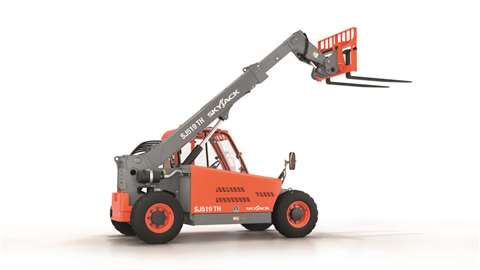
Skyjack says it has also experienced an increased demand for compact units. “Operators are continuing to utilise the compact telehandler for a wide range of applications as a result of its versatility through the use of attachments and its ability to manoeuvre easily around jobsite debris and tight corners,” says Braden Spence, junior product manager with Skyjack. “To address the high demand for the compact telehandler, Skyjack launched the SJ519 TH.”
The SJ519 TH, designed for the North American market, offers a 5,500-pound lift capacity and a maximum lift height of 19.1ft. With a fully opening door, operators can access their cab with ease. At its maximum reach of 11.25ft, the SJ519 TH can still lift a rated load of 4,400 pounds, Skyjack says. Also, all major service points are easily accessible. “Many compact telehandlers currently on jobsites in North America were designed with European industries, and European operators in mind,” Spence says. “The SJ519 TH was designed specifically for the North American market and features a class-leading cab size for ease of access for operators. For Skyjack, the launch of this product means that we now have the capability to compete in a whole new class of telehandlers.”
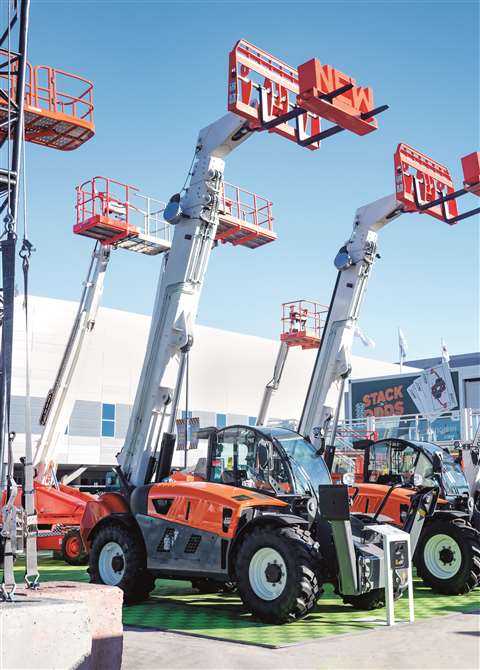
Fellow US company Snorkel launched two new telehandlers at Bauma 2019, as the new SR1442 and the SR1745 (branded as the SR9244 and SR1045 in the Americas) join the existing SR626 in the company’s range.
The new four-wheel-drive telehandlers are equipped with enclosed cabs with heat and air conditioning as standard. The SR1442 is capable of lifting up to 4.2 tonnes with a maximum lift height of up to 13.5m, and a maximum forward reach of up to 9.5m. The larger SR1745 has a maximum lift height of up to 16.4m, with a maximum forward reach of 12.6m, and can lift up to 4,535kg.
Traversing loads
The Pettibone Traverse T944X is aimed specifically at North America. An important feature is its extendable, traversing boom that moves loads by traveling horizontally. The 9,000 pound capacity machine has up to 70 inches of horizontal boom transfer, allowing users to precisely place loads at full lift height through tight openings.
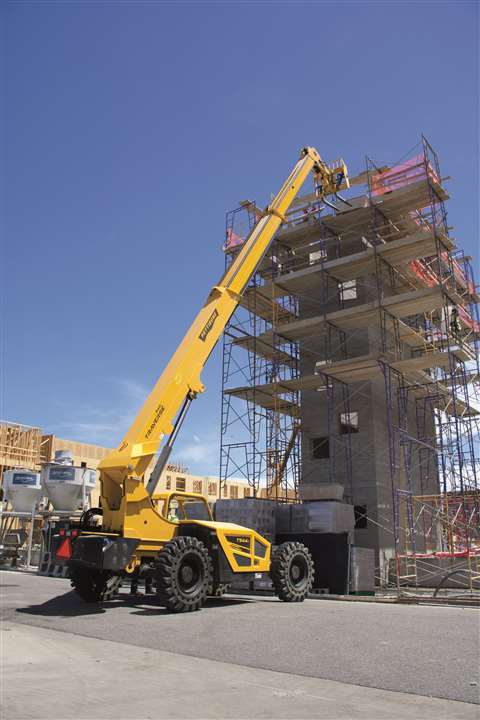
With the Traverse, the specified lift height of 44 feet, 6 inches is nearly identical to the 44ft landing height. This is in contrast to a traditional fixed boom pivot, where the true landing height is generally several feet less than the advertised lift height, as operators must account for withdrawing the forks out of the load with enough rearward travel for the fork tips to clear the landing zone. The traversing boom allows for maximum forward reach of 35ft, 10 inch.
Boom overlap has been nearly doubled from previous models to provide smoother operation and reduce contact forces on wear pads, thereby extending service life. A bottom-mounted external extend cylinder further reduces the load on wear pads by up to 50%.



